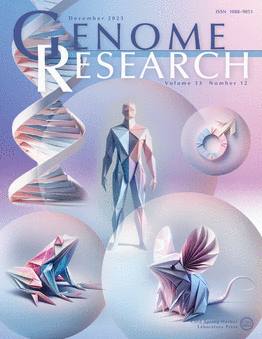Genetic variation in recalcitrant repetitive regions of the Drosophila melanogaster genome
IF 5.5
2区 生物学
Q1 BIOCHEMISTRY & MOLECULAR BIOLOGY
引用次数: 0
Abstract
Many essential functions of organisms are encoded in highly repetitive genomic regions, including histones involved in DNA packaging, centromeres that are core components of chromosome segregation, ribosomal RNA comprising the protein translation machinery, telomeres that ensure chromosome integrity, piRNA clusters encoding host defenses against selfish elements, and virtually the entire Y Chromosome. These regions, formed by highly similar tandem arrays, pose significant challenges for experimental and computational studies, impeding sequence-level descriptions essential for understanding genetic variation. Here, we report the assembly and variation analysis of such repetitive regions in Drosophila melanogaster, offering significant improvements to the existing community reference assembly. Our work successfully recovers previously elusive segments, including complete reconstructions of the histone locus and the pericentric heterochromatin of the X Chromosome, spanning the Stellate locus to the distal flank of the rDNA cluster. To infer structural changes in these regions where alignments are often not practicable, we introduce landmark anchors based on unique variants that are putatively orthologous. These regions display considerable structural variation between different D. melanogaster strains, exhibiting differences in copy number and organization of homologous repeat units between haplotypes. In the histone cluster, although we observe minimal genetic exchange indicative of meiotic crossing over, the variation patterns suggest mechanisms such as unequal sister chromatid exchange. We also examine the prevalence and scale of concerted evolution in the histone and Stellate clusters and discuss the mechanisms underlying these observed patterns.果蝇基因组中顽固性重复区域的遗传变异
生物体的许多基本功能都是在高度重复的基因组区域编码的,包括参与DNA包装的组蛋白、染色体分离的核心成分着丝粒、组成蛋白质翻译机制的核糖体RNA、确保染色体完整性的端粒、编码宿主防御自私元素的piRNA簇,以及几乎整个Y染色体。这些区域由高度相似的串联阵列组成,对实验和计算研究构成了重大挑战,阻碍了对理解遗传变异必不可少的序列水平描述。在此,我们报道了黑腹果蝇中这些重复区域的组装和变异分析,为现有的社区参考组装提供了重大改进。我们的工作成功地恢复了以前难以捉摸的片段,包括组蛋白位点和X染色体的周中心异染色质的完整重建,跨越星形位点到rDNA簇的远侧侧。为了推断这些区域的结构变化,我们引入了基于推定同源的独特变体的地标锚点。这些区域在不同菌株之间表现出相当大的结构差异,单倍型之间在拷贝数和同源重复单位的组织上存在差异。在组蛋白集群中,虽然我们观察到最小的遗传交换表明减数分裂交叉,但变异模式表明诸如姐妹染色单体交换不平等的机制。我们还研究了组蛋白和星形蛋白集群协同进化的普遍性和规模,并讨论了这些观察到的模式的机制。
本文章由计算机程序翻译,如有差异,请以英文原文为准。
求助全文
约1分钟内获得全文
求助全文
来源期刊

Genome research
生物-生化与分子生物学
CiteScore
12.40
自引率
1.40%
发文量
140
审稿时长
6 months
期刊介绍:
Launched in 1995, Genome Research is an international, continuously published, peer-reviewed journal that focuses on research that provides novel insights into the genome biology of all organisms, including advances in genomic medicine.
Among the topics considered by the journal are genome structure and function, comparative genomics, molecular evolution, genome-scale quantitative and population genetics, proteomics, epigenomics, and systems biology. The journal also features exciting gene discoveries and reports of cutting-edge computational biology and high-throughput methodologies.
New data in these areas are published as research papers, or methods and resource reports that provide novel information on technologies or tools that will be of interest to a broad readership. Complete data sets are presented electronically on the journal''s web site where appropriate. The journal also provides Reviews, Perspectives, and Insight/Outlook articles, which present commentary on the latest advances published both here and elsewhere, placing such progress in its broader biological context.
 求助内容:
求助内容: 应助结果提醒方式:
应助结果提醒方式:


